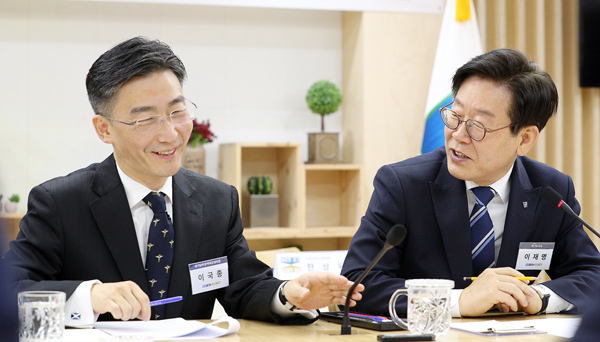Gyeonggi Province said it has allowed air ambulances, locally known as “doctor helicopters,” to land in and take off from public agencies, school playgrounds, and parks in the province.
The decision aims to tackle the problem of having difficulty in transporting patients with severe trauma amid the lack of landing and takeoff zones, it said.
Gyeonggi Province signed an agreement with Gyeonggi Office of Education and Ajou University Hospital to provide more landing zones for helicopters for emergency medicine at the provincial government office in Suwon, Tuesday.
Gyeonggi Province Governor Lee Jae-myung, Ajou University Hospital Director Han Sang-uk, and Ajou University Hospital Southern Gyeonggi Province Severe Trauma Center Head Lee Cook-jong attended the signing ceremony.
The agreement raises the number of landing sites from the present 588 for firefighting helicopters to 2,420, including 77 government agencies and 1,755 school playgrounds, within Gyeonggi Province.
The nation has only 828 landing sites for air ambulances. Due to the lack of such zones, deployment of choppers had to be canceled 80 times in the past three years, Gyeonggi Province said.

‘I will take responsibility for every problem caused by helicopter landing’
Gyeonggi Province Governor Lee’s strong commitment led the province to secure more landing zones for doctor helicopters. Lee said he would take responsibility for all the problems caused by the landing of helicopters in emergencies.
Lee gave out “an administrative order on doctor helicopters to make emergency landing” so that Gyeonggi Disaster and Safety Headquarters would not hesitate in ordering emergency landings.
In a life-threatening situation, worries about legal problems such as causing property damage or trespassing should not interfere with doctor helicopters’ swift landing to transport urgent patients immediately, he said.
“Emergency rescues are classified as 'emergency disasters' under the current law. When lives are at stake, acts such as trespassing or destruction of property can be permitted. For example, even when a company ground where you can drop a helicopter is locked, you can boldly land it,” Lee said.
He ordered officials to make use of the agreement with government agencies and schools and provide a guideline for the disaster and safety headquarters so that helicopters can make an emergency landing in urgent situations.
“Gyeonggi Province will take care of every problem caused by a helicopter’s emergency landing in a disaster situation. We should show how hard people have to work to save a single person’s life. Please use this system actively,” he said.
Trauma surgeon hopes Gyeonggi case to spread across the nation
Lee Cook-jong, a trauma specialist at Ajou University Hospital and the head of the Southern Gyeonggi Severe Trauma Center, welcomed the agreement and hoped that the entire nation could adopt such a system.
“This is not about simply securing landing zones for helicopters but showing a new paradigm that Korean society should take to move forward,” Lee said.
When Lee was working as a trauma surgeon on air ambulances in London, most landing zones were school playgrounds, he explained. Teachers would stop the class and come out on the playground to show students the scene of air ambulance landing, he recalled.
“Teachers would say it was the most important field education to help students deeply recognize how much they should respect life. Watching them doing so, I wanted to make that happen in Korea, too,” he said.
“The reality has not been easy here, however. I thank Governor Lee for his efforts to adopt the advanced nation’s model and help Korea move forward,” Lee added.

